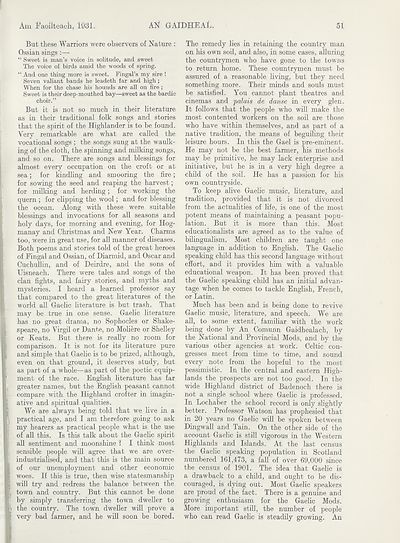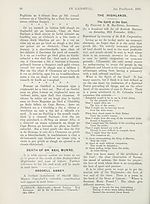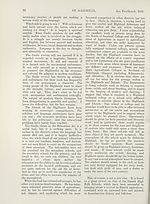An Comunn Gàidhealach Publications > Gaidheal > Volume 26, October 1930--September 1931
(71) Page 51
Download files
Complete book:
Individual page:
Thumbnail gallery: Grid view | List view

Am IWlteach, 1981.
AN GAIDHEAL.
51
But these Warriors were observers of Nature :
Ossian sings:—
“ Sweet is man’s voice in solitude, and sweet
The voice of birds amid the woods of spring.
“ And one thing more is sweet. Fingal’s my sire !
Seven valiant bands he leadeth far and high;
When for the chase his hounds are all on fire;
Sweet is their deep-mouthed bay—sweet as the bardie
choir.”
But it is not so much in their literature
as in their traditional folk songs and stories
that the spirit of the Highlander is to be found.
Very remarkable are what are called the
vocational songs ; the songs sung at the waulk-
ing of the cloth, the spinning and milking songs,
and so on. There are songs and blessings for
almost every occupation on the croft or at
sea; for kindling and smcoring the fire;
for sowing the seed and reaping the harvest;
for milking and herding; for working the
quern ; for clipping the wool; and for blessing
the ocean. Along with these were suitable
blessings and invocations for all seasons and
holy days, for morning and evening, for Hog¬
manay and Christmas and New Year. Charms
too, were in great use, for all manner of diseases.
Both poems and stories told of the great heroes
of Fingal and Ossian, of Diarmid, and Oscar and
Cuchullin, and of Deirdre, and the sons of
Uisneach. There were tales and songs of the
clan fights, and fairy stories, and myths and
mysteries. I heard a learned professor say
that compared to the great literatures of the
world all Gaelic literature is but trash. That
may be true in one sense. Gaelic literature
has no great drama, no Sophocles or Shake¬
speare, no Virgil or Dante, no Moliere or Shelley
or Keats. But there is really no room for
comparison. It is not for its literature pure
and simple that Gaelic is to be prized, although,
even on that ground, it deserves study, but
as part of a whole—as part of the poetic equip¬
ment of the race. English literature has far
greater names, but the English peasant cannot
compare with the Highland crofter in imagin¬
ative and spiritual qualities.
We are always being told that we live in a
practical age, and I am therefore going to ask
my hearers as practical people what is the use
of all this. Is this talk about the Gaelic spirit
all sentiment and moonshine ? I think most
sensible people will agree that we are over¬
industrialised, and that this is the main source
of our unemployment and other economic
woes. If this is true, then wise statesmanship
will try and redress the balance between the
town and country. But this cannot be done
by simply transferring the town dweller to
the country. The town dweller will prove a
very bad farmer, and he will soon be bored.
The remedy lies in retaining the country man
on his own soil, and also, in some cases, alluring
the countrymen who have gone to the towns
to return home. These countrymen must be
assured of a reasonable living, but they need
something more. Their minds and souls must
be satisfied. You cannot plant theatres and
cinemas and palais de danse in every glen.
It follows that the people who will make the
most contented workers on the soil are those
who have within themselves, and as part of a
native tradition, the means of beguiling their
leisure hours. In this the Gael is pre-eminent.
He may not be the best farmer, his methods
may be primitive, he may lack enterprise and
initiative, but he is in a very high degree a
child of the soil. He has a passion for his
own countryside.
To keep alive Gaelic music, literature, and
tradition, provided that it is not divorced
from the actualities of life, is one of the most
potent means of maintaining a peasant popu¬
lation. But it is more than this. Most
educationalists are agreed as to the value of
bilingualism. Most children are taught one
language in addition to English. The Gaelic
speaking child has this second language without
effort, and it provides him with a valuable
educational weapon. It has been proved that
the Gaelic speaking child has an initial advan¬
tage when he comes to tackle English, French,
or Latin.
Much has been and is being done to revive
Gaelic music, literature, and speech. We are
all, to some extent, familiar with the work
being done by An Comunn Gaidhealach, by
the National and Provincial Mods, and by the
various other agencies at work. Celtic con¬
gresses meet from time to time, and sound
every note from the hopeful to the most
pessimistic. In the central and eastern High¬
lands the prospects are not too good. In the
wide Highland district of Badenoch there is
not a single school where Gaelic is professed.
In Lochaber the school record is only slightly
better. Professor Watson has prophesied that
in 20 years no Gaelic will be spoken between
Dingwall and Tain. On the other side of the
account Gaelic is still vigorous in the Western
Highlands and Islands. At the last census
the Gaelic speaking population in Scotland
numbered 161,473, a fall of over 69,000 since
the census of 1901. The idea that Gaelic is
a drawback to a child, and ought to be dis¬
couraged, is dying out. Most Gaelic speakers
are proud of the fact. There is a genuine and
growing enthusiasm for the Gaelic Mods.
More important still, the number of people
who can read Gaelic is steadily growing. An
AN GAIDHEAL.
51
But these Warriors were observers of Nature :
Ossian sings:—
“ Sweet is man’s voice in solitude, and sweet
The voice of birds amid the woods of spring.
“ And one thing more is sweet. Fingal’s my sire !
Seven valiant bands he leadeth far and high;
When for the chase his hounds are all on fire;
Sweet is their deep-mouthed bay—sweet as the bardie
choir.”
But it is not so much in their literature
as in their traditional folk songs and stories
that the spirit of the Highlander is to be found.
Very remarkable are what are called the
vocational songs ; the songs sung at the waulk-
ing of the cloth, the spinning and milking songs,
and so on. There are songs and blessings for
almost every occupation on the croft or at
sea; for kindling and smcoring the fire;
for sowing the seed and reaping the harvest;
for milking and herding; for working the
quern ; for clipping the wool; and for blessing
the ocean. Along with these were suitable
blessings and invocations for all seasons and
holy days, for morning and evening, for Hog¬
manay and Christmas and New Year. Charms
too, were in great use, for all manner of diseases.
Both poems and stories told of the great heroes
of Fingal and Ossian, of Diarmid, and Oscar and
Cuchullin, and of Deirdre, and the sons of
Uisneach. There were tales and songs of the
clan fights, and fairy stories, and myths and
mysteries. I heard a learned professor say
that compared to the great literatures of the
world all Gaelic literature is but trash. That
may be true in one sense. Gaelic literature
has no great drama, no Sophocles or Shake¬
speare, no Virgil or Dante, no Moliere or Shelley
or Keats. But there is really no room for
comparison. It is not for its literature pure
and simple that Gaelic is to be prized, although,
even on that ground, it deserves study, but
as part of a whole—as part of the poetic equip¬
ment of the race. English literature has far
greater names, but the English peasant cannot
compare with the Highland crofter in imagin¬
ative and spiritual qualities.
We are always being told that we live in a
practical age, and I am therefore going to ask
my hearers as practical people what is the use
of all this. Is this talk about the Gaelic spirit
all sentiment and moonshine ? I think most
sensible people will agree that we are over¬
industrialised, and that this is the main source
of our unemployment and other economic
woes. If this is true, then wise statesmanship
will try and redress the balance between the
town and country. But this cannot be done
by simply transferring the town dweller to
the country. The town dweller will prove a
very bad farmer, and he will soon be bored.
The remedy lies in retaining the country man
on his own soil, and also, in some cases, alluring
the countrymen who have gone to the towns
to return home. These countrymen must be
assured of a reasonable living, but they need
something more. Their minds and souls must
be satisfied. You cannot plant theatres and
cinemas and palais de danse in every glen.
It follows that the people who will make the
most contented workers on the soil are those
who have within themselves, and as part of a
native tradition, the means of beguiling their
leisure hours. In this the Gael is pre-eminent.
He may not be the best farmer, his methods
may be primitive, he may lack enterprise and
initiative, but he is in a very high degree a
child of the soil. He has a passion for his
own countryside.
To keep alive Gaelic music, literature, and
tradition, provided that it is not divorced
from the actualities of life, is one of the most
potent means of maintaining a peasant popu¬
lation. But it is more than this. Most
educationalists are agreed as to the value of
bilingualism. Most children are taught one
language in addition to English. The Gaelic
speaking child has this second language without
effort, and it provides him with a valuable
educational weapon. It has been proved that
the Gaelic speaking child has an initial advan¬
tage when he comes to tackle English, French,
or Latin.
Much has been and is being done to revive
Gaelic music, literature, and speech. We are
all, to some extent, familiar with the work
being done by An Comunn Gaidhealach, by
the National and Provincial Mods, and by the
various other agencies at work. Celtic con¬
gresses meet from time to time, and sound
every note from the hopeful to the most
pessimistic. In the central and eastern High¬
lands the prospects are not too good. In the
wide Highland district of Badenoch there is
not a single school where Gaelic is professed.
In Lochaber the school record is only slightly
better. Professor Watson has prophesied that
in 20 years no Gaelic will be spoken between
Dingwall and Tain. On the other side of the
account Gaelic is still vigorous in the Western
Highlands and Islands. At the last census
the Gaelic speaking population in Scotland
numbered 161,473, a fall of over 69,000 since
the census of 1901. The idea that Gaelic is
a drawback to a child, and ought to be dis¬
couraged, is dying out. Most Gaelic speakers
are proud of the fact. There is a genuine and
growing enthusiasm for the Gaelic Mods.
More important still, the number of people
who can read Gaelic is steadily growing. An
Set display mode to:
![]() Universal Viewer |
Universal Viewer | ![]() Mirador |
Large image | Transcription
Mirador |
Large image | Transcription
| An Comunn Gàidhealach > An Comunn Gàidhealach Publications > Gaidheal > Volume 26, October 1930--September 1931 > (71) Page 51 |
|---|
| Permanent URL | https://digital.nls.uk/125153256 |
|---|
| Description | This contains items published by An Comunn, which are not specifically Mòd-related. It includes journals, annual reports and corporate documents, policy statements, educational resources and published plays and literature. It is arranged alphabetically by title. |
|---|
| Description | A collection of over 400 items published by An Comunn Gàidhealach, the organisation which promotes Gaelic language and culture and organises the Royal National Mòd. Dating from 1891 up to the present day, the collection includes journals and newspapers, annual reports, educational materials, national Mòd programmes, published Mòd literature and music. |
|---|---|
| Additional NLS resources: |
|

